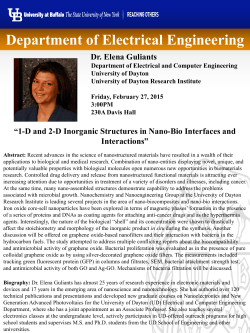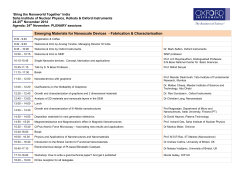
Graphene based energy devices - Case Western Reserve University
Volume 7 Number 16 28 April 2015 Pages 6861–7446 Nanoscale www.rsc.org/nanoscale Themed issue: Graphene based energy devices ISSN 2040-3364 EDITORIAL Abd. Rashid bin Mohd Yusoff, Liming Dai, Hui-Ming Cheng, Jie Liu Graphene based energy devices Nanoscale View Article Online EDITORIAL View Journal | View Issue Graphene based energy devices Cite this: Nanoscale, 2015, 7, 6881 Abd. Rashid bin Mohd Yusoff,*a Liming Dai,*b Hui-Ming Cheng*c and Jie Liu*d Received 11th March 2015, Accepted 11th March 2015 Published on 25 March 2015. Downloaded on 20/04/2015 15:13:26. DOI: 10.1039/c5nr90062j www.rsc.org/nanoscale In recent years, there has been an upsurge of scientific interest in using carbon and its derivatives in a host of fields including the physical, chemical and biological sciences. Graphene, the one-atom thick sheet (2D) of sp2-hybridized carbon atoms arranged in a hexagonal fashion, is in principle the building block of some of the most important graphitic carbon materials of all the other dimensionalities including graphite (3D), carbon nanotubes (1D), and fullerenes (0D).1 Owing to its unique structure and outstanding properties, graphene has held a star role in the scientific community ever since its discovery. Graphene is known to have extraordinary electrical and thermal conductivities, a very high mechanical strength,2,3 and a very high theoretical specific surface area (>2600 m2 g−1). These excellent properties of graphene make it promising for a host of applications including energy storage,4–6 energy conversion,7–9 electronics,10 coma Advanced Display Research Center, Department of Information Display, Kyung Hee University, Dongdaemoon-gu, Seoul 130-701, South Korea. E-mail: abdr@khu.ac.kr b Center of Advanced Science and Engineering for Carbon (Case4Carbon), Department of Macromolecular Science and Engineering, Case Western Reserve University, 10900 Euclid Avenue, Cleveland, USA. E-mail: liming.dai@case.edu c Shenyang National Laboratory for Materials Science, Institute of Metal Research, Chinese Academy of Sciences, 72 Wenhua Road, Shenyang 110016, China. E-mail: gangliu@imr.ac.cn d Department of Chemistry, Duke University, Durham, North Carolina 27708, USA. E-mail: j.liu@duke.edu This journal is © The Royal Society of Chemistry 2015 posites,11 biotechnology,12 etc. The high electrical conductivity, excellent mechanical strength and high theoretical surface area make this material particularly suitable for energy storage devices as a functional electrode material either by itself or in conjunction with other materials. The articles in this issue cover the latest developments in device architecture, large-scale processes in line quality control tools, and manufacturing processes for numerous energy devices. The minireview by He et al. demonstrates that graphene-based anodes can improve microbial fuel cells in terms of enhanced electron transfer efficiency, higher specific surface are and more active microbe–electrode–electrolyte interactions (DOI: 10.1039/C4NR05637J). In addition, Kinloch and co-workers emphasize the potential of electrochemical-based methods as promising approaches to the solution phase preparation of graphene materials (DOI: 10.1039/C4NR06942K). Another comprehensive review by Chen et al. summarizes recent progress in three-dimensional graphene-based composite materials and their potential applications in energy/ storage devices including supercapacitors, lithium-ion batteries, dye-sensitized solar cells and fuel cells. They discussed the fact that three-dimensional graphenebased composites are determined by their electronic, electrochemical and structural properties. Graphene offers great progress in energy-based storage devices, which is demonstrated by an article that employed mildly reduced graphene oxide as a cathode material for lithium– sulfur batteries (DOI: 10.1039/ C4NR07663J). Ahn and co-workers demonstrate additive-free thick graphene as an anode material for flexible lithium-ion batteries (DOI: 10.1039/ C4NR06082B). Their thick graphene and flexible graphene exhibited excellent mechanical flexibility and could be bent into any desired structure. Moreover, the versatility of graphene has been demonstrated by Zhang and co-workers, where they demonstrate high-rate and longcycle-life supercapacitors (DOI: 10.1039/ C4NR06527A). Their hybrid graphene shows excellent electrochemical performance including an ultra-high specific capacitance and a superior longterm cycling stability with only 6% capacitance loss. This article also demonstrates the possibility of constructing binder- and additive-free pseudocapacitive devices with an excellent rate capability and a long-term life cycle. The abovementioned work is further supported by that of Chen et al., in which they describe several fabrication strategies to scientifically design binder-free and self-standing graphene materials for achieving better capacitance performance (DOI: 10.1039/ C4NR05895J). One of the discussed strategies has been implemented by Ozkan et al. in their supercapacitors by performing UV-ozone treatment (DOI: 10.1039/C4NR06795A). In their study, they demonstrate the transition of Nanoscale, 2015, 7, 6881–6882 | 6881 View Article Online Published on 25 March 2015. Downloaded on 20/04/2015 15:13:26. Editorial graphene and carbon nanotube hybrid foam nanostructures from hydrophobic to hydrophilic depending on the treatment time. Another interesting work by Li and co-workers reports a simple and effective electrostatic method to attach molybdenum oxide belts onto a graphene template to promote the hydrogen evolution reaction (DOI: 10.1039/ C4NR06624C). They demonstrate that the π-electrons on graphene facilitate the reduction of molybdenum oxide, and that the presence of graphene and hydrogen leads to flaws in the defect sites in the molybdenum oxide belts. The current shortcoming for fuel cells and metal–air batteries lies in the sluggish oxygen reduction reaction on the cathode side. The development of a simple highly active electrocatalyst for the oxygen reduction reaction is introduced by Yang et al. (DOI: 10.1039/ C4NR05917D). On the other hand, Xu et al. (DOI: 10.1039/C4NR05879H) show a facile one-step reflux route to synthesize an enhanced visible light photocatalytic material. The higher photoactivity of their proposed photocatalytic material is attributed to the more efficient electron relay from an excited state, with improved electron transfer efficiency and electronic conductivity. Moreover, a series of articles based on energy generation devices further demonstrates the usefulness of graphene in the optoelectronic and photonics industries. An overview article by Baek and co-workers (DOI: 10.1039/ C4NR06831A) discusses the recent developments of non-precious metal catalysts for the oxygen reduction reaction in fuel cells. They emphasize that graphene supported non-precious metal catalysts demonstrate highly improved stabilities. Wang and co-workers (DOI: 10.1039/C4NR06856D) demonstrate efficient enzyme immobilization and improved enzyme loading which facilitate direct electron transfer. Their proposed graphene/enzyme network-based enzymatic biofuel cells exhibit almost seven times the maximum power density compared to that of bare carbon micropillar array-based enzymatic biofuel 6882 | Nanoscale, 2015, 7, 6881–6882 Nanoscale cells. Dai et al. (DOI: 10.1039/ C4NR06969B) further demonstrate nitrogen-doped graphene nanoribbons as efficient metal-free counter electrodes in dye-sensitized solar cells. Their superior performance is attributed to the improved charge transfer capability and electrocatalytic activity induced by nitrogen doping of the graphene nanoribbons. Moreover, tuning the work function of a graphene film can be controlled by doping with an electrical field. This concept has been demonstrated by Yang and co-workers (DOI: 10.1039/ C4NR06677D) by either connecting the graphene–silicon solar cell to an external power supply or by polarizing a ferroelectric layer integrated in the graphene– silicon solar cell. Their study shows how one can manipulate the work function and sheet resistance of graphene. Jang et al. (DOI: 10.1039/C4NR05874G) demonstrate the versatility of nitrogendoped graphene as an anode buffer layer in both plasmonic polymer solar cells and organic light emitting diodes. Their findings show that graphene can replace our commonly used anode buffer layer, poly(3,4-ethylenedioxythiophene) : poly(4-styrenesulfonate). In summary, the compiled articles in this Nanoscale themed issue demonstrate the great potential and versatility of graphene to be deployed in optoelectronic and photonic devices. A few approaches that highlight the usefulness of graphene are presented. A novel route to enhance catalytic behavior is also discussed. Moreover, the approaches that combine plasmonic solar cells with graphene further demonstrate the great potential of this two-dimensional material for advanced photovoltaic applications. We hope that this themed issue will promote the future generation of novel graphene-based energy devices. Finally, we would like to thank all contributors to this themed issue. References 1 A. K. Geim and K. S. Novoselov, The rise of graphene, Nat. Mater., 2007, 6, 183–191. 2 J. U. Lee, D. Yoon and H. Cheong, Estimation of Young’s Modulus of Graphene by Raman Spectroscopy, Nano Lett., 2012, 12, 4444–4448. 3 T. J. Booth, P. Blake, R. R. Nair, et al., Macroscopic Graphene Membranes and Their Extraordinary Stiffness, Nano Lett., 2008, 8, 2442–2446. 4 A. Dhanabalan, X. Li, R. Agrawal, et al., Fabrication and Characterization of SnO2/Graphene Composites as High Capacity Anodes for Li-Ion Batteries, Nanomaterials, 2013, 3, 606–614. 5 F. Liu, C. Wee Lee and J. S. Im, Graphene-Based Carbon Materials for Electrochemical Energy Storage, J. Nanomater., 2013, 642915. 6 M. Beidaghi, Z. Wang and L. Gu, Electrostatic spray deposition of graphene nanoplatelets for high-power thin-film supercapacitor electrodes, J. Solid State Electrochem., 2012, 16, 3341–3348. 7 S. J. Lee, J. Y. Kim, A. R. B. M. Yusoff and J. Jang, Plasmonic organic solar cell employing Au NP:PEDOT:PSS doped rGO, RSC Adv., 2015, 5, 23892– 23899. 8 A. R. B. M. Yusoff, S. J. Lee, F. K. Schneider, W. J. da Silva and J. Jang, High-Performance Semitransparent Tandem Solar Cell of 8.02% Conversion Efficiency with SolutionProcessed Graphene Mesh and Laminated Ag Nanowire Top Electrodes, Adv. Energy Mater., 2014, 4, 150– 158. 9 A. R. B. M. Yusoff, H. P. Kim and J. Jang, High Performance Organic Photovoltaic with Graphene Oxide and Zinc Oxide Buffer Layers, Nanoscale, 2014, 6, 1537–1544. 10 F. Schwierz, Graphene Transistors, Nat. Nanotechnol., 2010, 5, 487– 496. 11 S. Stankovich, D. A. Dikin, G. H. B. Dommett, et al., Graphenebased composite materials, Nature, 2006, 442, 282–286. 12 X. Zhou and F. Liang, Application of Graphene/Graphene Oxide in Biomedicine and Biotechnology, Curr. Med. Chem., 2014, 21, 855–869. This journal is © The Royal Society of Chemistry 2015
© Copyright 2025










